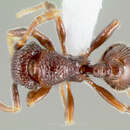en
names in breadcrumbs


Taxonomic history
See also: Bolton, 1981b PDF: 257.Cyphoidris spinosus Weber , 1952: 26, figs 7, 8. Holotype worker, Zaire: Ituri Forest, 15 miles [24 km] N. of Beni, 25. ii. 1948, no. 2129.2 (N. A. Weber) (AMNH, New York) [examined].
Worker. TL 3.8 - 4.3, HL 0.90 - 0.98, HW 0.81 - 0.91, CI 88 - 93, SL 0.68 - 0.76, SI 83 - 86, PW 0.60 - 0.72, AL 1.08 - 1.22 (10 measured).
Mandibles smooth with scattered pits or at most with faint traces of fine longitudinal striation; number of small teeth on mandible varying from 10 - 12. Anterior clypeal margin arcuate or with a very shallow impression medially, the median portion of the clypeus raised and bicarinate longitudinally. Main features of head as in generic diagnosis and Fig. 16. Eyes of moderate size, maximum diameter 0.16 - 0.18, about 0.20 - 0.22 x HW, situated below the ventral margin of the scrobe and in front of the midlength of the sides of the head. Frontal carinae sharply defined, relatively close together and diverging slightly posteriorly but in general not becoming radically broader than the distance across the frontal lobes. At eye level the separation of the frontal carinae is 0.36 - 0.42, about 0.44 - 0.46 x HW.
Outline of alitrunk as in Fig. 15, the promesonotum conspicuously swollen and on a much higher level than the propodeal dorsum. Propodeum armed with a pair of strong spines which are straight to feebly upcurved. Metanotal groove absent; metapleural lobes triangular and conspicuous. Petiole in profile with an elongate peduncle and a well developed node, the dorsum of the node sloping downwards posteriorly so that the posterior face is short. Anterior and dorsal surfaces of postpetiole forming a single convexity, the posterior face truncated. In dorsal view the nodes of both the petiole and postpetiole broader than long. Dorsum of head strongly longitudinally rugose, with 5 - 7 rugae between the frontal carinae at eye-level. The rugae are irregular and tend to meander slightly, a few anastomoses usually being present. Scrobal area for the most part smooth but usually with 1 - 2 fine rugulae traversing the width of the scrobe behind the antennal fossa. Sides of head behind eyes finely reticulate-rugose, this sculpture extending round the posterior margins of the scrobes to the occiput. Spaces between rugae everywhere on head unsculptured or at most with the faintest superficial traces. Dorsal alitrunk everywhere finely but strongly reticulate-rugose with broad shining interspaces. Petiole dorsum rugulose, the postpetiole varying from rugulose to only faintly sculptured. Gaster unsculptured. All dorsal surfaces of head and body densely clothed with fine acute hairs. Colour dark reddish brown to blackish brown.
C. spinosa , known only from Zaire, Ivory Coast and Angola, is a leaf litter inhabiting species of the forest zone. The closest related species of the genus, exalta , is compared with spinosa below.
Material examined Angola: Duque de Braganca Falls (P. M. Hammond). Ivory Coast: Agbo ville (/. Loebl).